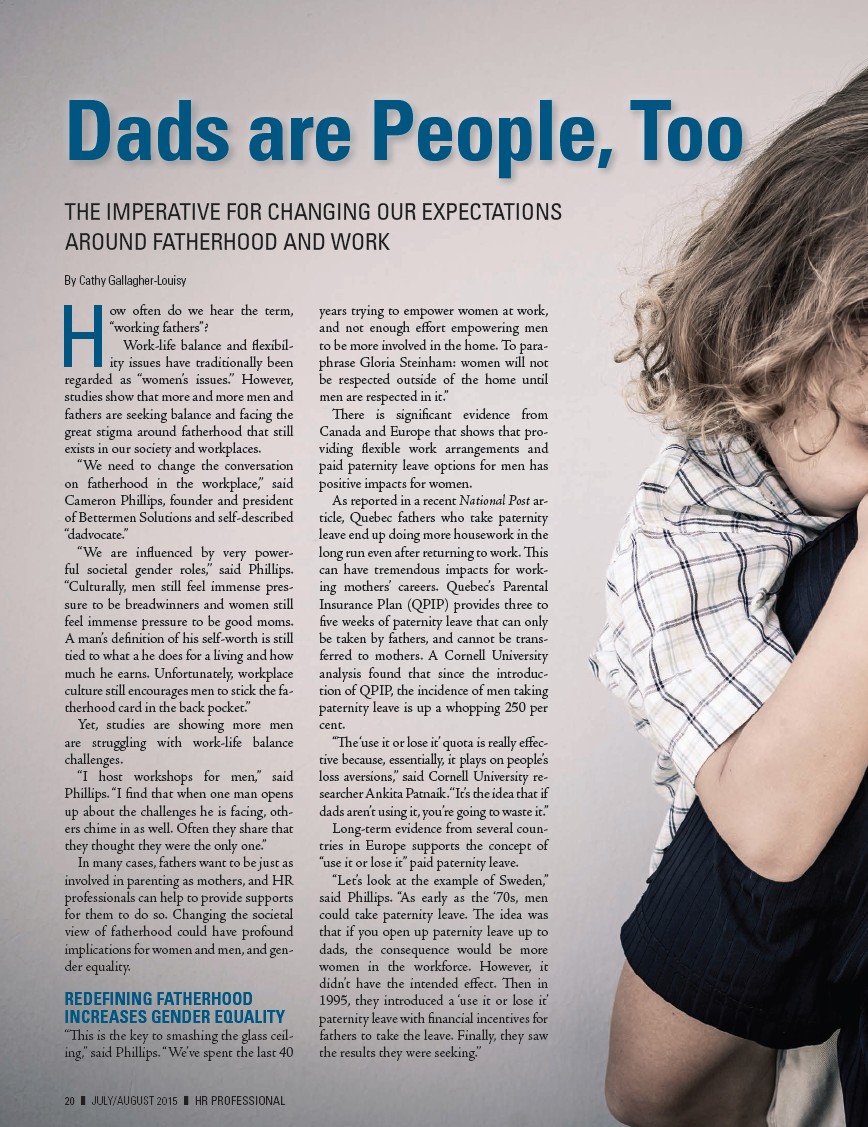
Dads are People, Too
THE IMPERATIVE FOR CHANGING OUR EXPECTATIONS
AROUND FATHERHOOD AND WORK
By Cathy Gallagher-Louisy
How often do we hear the term,
“working fathers”?
Work-life balance and flexibility
issues have traditionally been
regarded as “women’s issues.” However,
studies show that more and more men and
fathers are seeking balance and facing the
great stigma around fatherhood that still
exists in our society and workplaces.
“We need to change the conversation
on fatherhood in the workplace,” said
Cameron Phillips, founder and president
of Bettermen Solutions and self-described
“dadvocate.”
“We are influenced by very powerful
societal gender roles,” said Phillips.
“Culturally, men still feel immense pressure
to be breadwinners and women still
feel immense pressure to be good moms.
A man’s definition of his self-worth is still
tied to what a he does for a living and how
much he earns. Unfortunately, workplace
culture still encourages men to stick the fatherhood
card in the back pocket.”
Yet, studies are showing more men
are struggling with work-life balance
challenges.
“I host workshops for men,” said
Phillips. “I find that when one man opens
up about the challenges he is facing, others
chime in as well. Often they share that
they thought they were the only one.”
In many cases, fathers want to be just as
involved in parenting as mothers, and HR
professionals can help to provide supports
for them to do so. Changing the societal
view of fatherhood could have profound
implications for women and men, and gender
equality.
REDEFINING FATHERHOOD
INCREASES GENDER EQUALITY
“This is the key to smashing the glass ceiling,”
said Phillips. “We’ve spent the last 40
years trying to empower women at work,
and not enough effort empowering men
to be more involved in the home. To paraphrase
Gloria Steinham: women will not
be respected outside of the home until
men are respected in it.”
There is significant evidence from
Canada and Europe that shows that providing
flexible work arrangements and
paid paternity leave options for men has
positive impacts for women.
As reported in a recent National Post article,
Quebec fathers who take paternity
leave end up doing more housework in the
long run even after returning to work. This
can have tremendous impacts for working
mothers’ careers. Quebec’s Parental
Insurance Plan (QPIP) provides three to
five weeks of paternity leave that can only
be taken by fathers, and cannot be transferred
to mothers. A Cornell University
analysis found that since the introduction
of QPIP, the incidence of men taking
paternity leave is up a whopping 250 per
cent.
“The ‘use it or lose it’ quota is really effective
because, essentially, it plays on people’s
loss aversions,” said Cornell University researcher
Ankita Patnaik. “It’s the idea that if
dads aren’t using it, you’re going to waste it.”
Long-term evidence from several countries
in Europe supports the concept of
“use it or lose it” paid paternity leave.
“Let’s look at the example of Sweden,”
said Phillips. “As early as the ‘70s, men
could take paternity leave. The idea was
that if you open up paternity leave up to
dads, the consequence would be more
women in the workforce. However, it
didn’t have the intended effect. Then in
1995, they introduced a ‘use it or lose it’
paternity leave with financial incentives for
fathers to take the leave. Finally, they saw
the results they were seeking.”
20 ❚ JULY/AUGUST 2015 ❚ HR PROFESSIONAL